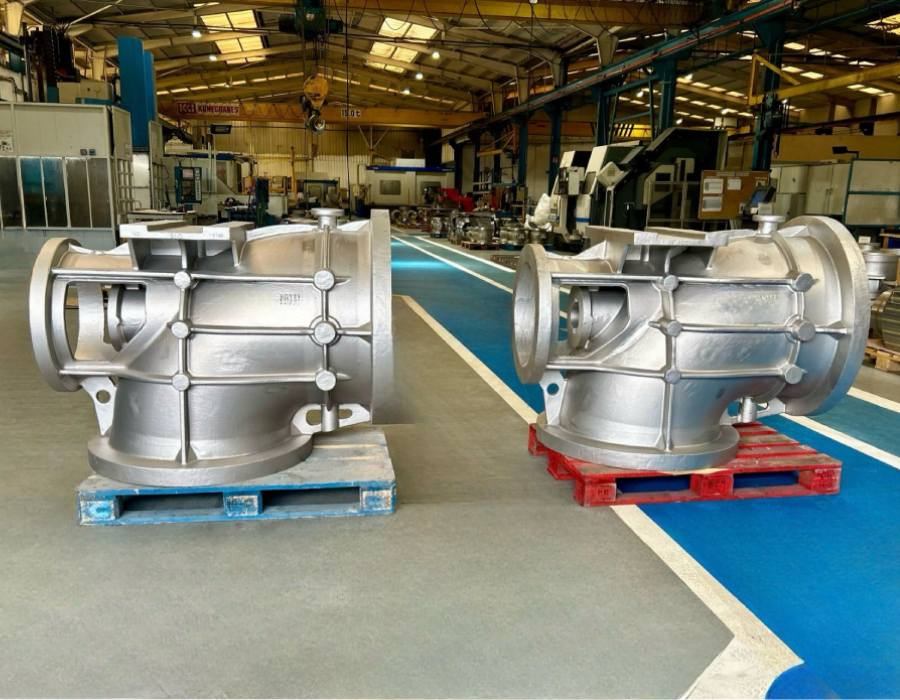Machined predictive maintenance vs corrective maintenance is a key dilemma for manufacturers of industrial components seeking to reduce failures and costs. The comparison between machined predictive maintenance and corrective maintenance allows industrial manufacturers to choose the most effective strategy to minimize failures and costs in critical pumps and valves. This approach helps prevent costly errors in critical components subject to wear, such as industrial pumps or cryogenic valves. Companies that still rely exclusively on preventive or corrective maintenance risk facing unexpected shutdowns, loss of performance, and unnecessary costs.
Do you want to anticipate failures and avoid hidden costs?
Are you a manufacturer of industrial pumps or valves looking to stay ahead of the most critical failures?
At Asimer Group, we help you analyze your components, apply specialized coatings, and define a tailored predictive maintenance strategy.
👉 Tell us about your case. We’re ready to help.So, what’s the most effective strategy to ensure your equipment keeps running? In this article, we offer a clear comparison based on data, algorithms, predictive analytics, and techniques applied to CNC machining.
At Asimer Group, specialists in precision CNC machining and technical welding for industrial pumps and valves, we work alongside manufacturers to implement predictive maintenance strategies based on real data and critical tolerances.
Additionally, correctly identifying the different types of industrial valves and applying the right types of non-destructive testing is key to designing an efficient maintenance strategy. For butterfly valves, for example, it is essential to consider their specific behavior in continuous or batch processes, as this directly affects wear, the need for periodic inspections, and the type of maintenance to apply—predictive or corrective.
Such tailored maintenance decisions are increasingly supported by advanced technologies. In fact, the trend toward proactive maintenance relies on connected systems and sensors that allow failures to be anticipated before they occur.
This transformation is driving the digitalization of critical assets in sectors such as Oil & Gas, Industry 4.0, cryogenics, petrochemicals, water treatment, energy generation, and industrial processes where reliability and operational efficiency are crucial.
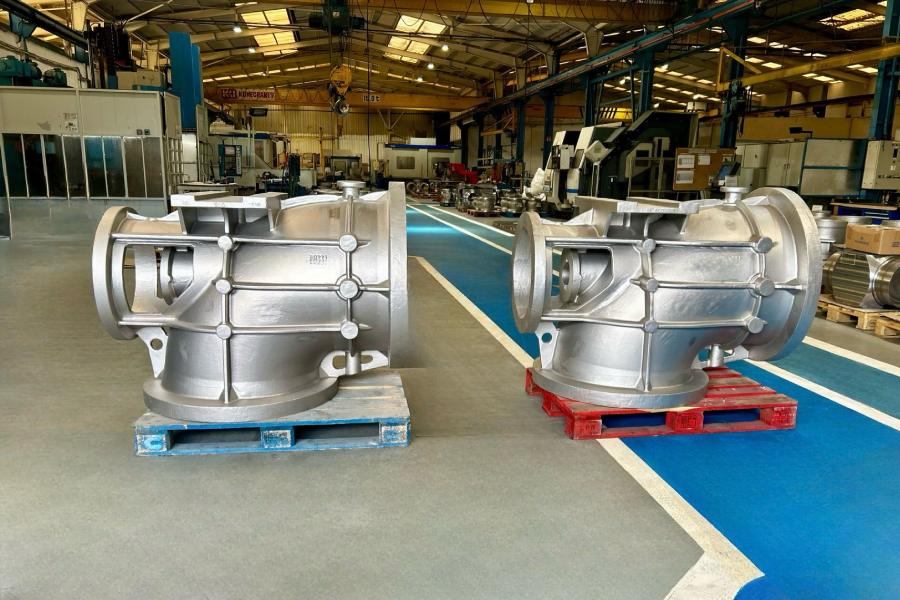
Technologies involved in predictive and preventive maintenance
- IoT sensors applied to industrial pumps, valves, and rotating equipment
- Real-time analysis of vibrations, temperature, and pressure
- Automated measurement with CNC machining tools
- Machine learning and AI
- Integration with SCADA, data storage, and traceability
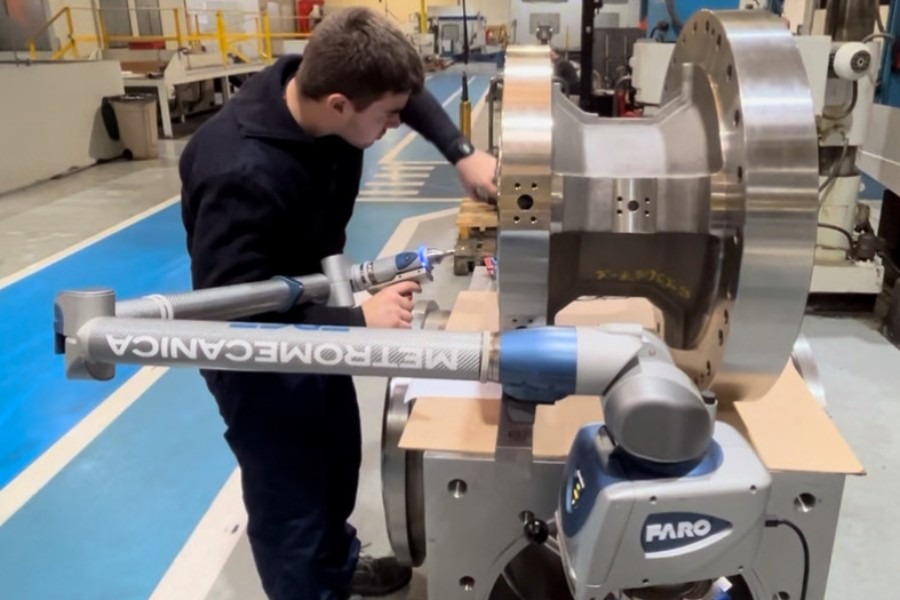
Technical details
The most commonly used sensors for valves and pumps include accelerometers (for vibration), differential pressure sensors, flowmeters, and thermocouples. When this data is integrated with platforms like PI System, CMMS, or SCADA dashboards, it allows for automatic alerts and critical thresholds to be set based on real equipment histories.
In water treatment or desalination projects, predictive maintenance is essential for anticipating failures in centrifugal pumps, gate, or butterfly valves exposed to highly saline, abrasive, or corrosive environments. While cryogenic valves are not commonly used in these settings, materials like austenitic stainless steels or alloys with resilient coatings such as Stellite® are also applied in industrial valves designed to withstand chlorides and aggressive fluids.
For manufacturers of centrifugal pumps and industrial valves, we’ve developed specific solutions combining technical coatings like Stellite® with TIG welding and dimensional control, ensuring tightness even in aggressive environments.
Monitoring parameters such as vibration, differential pressure, or internal wear allows you to detect abnormal conditions before a failure occurs, improving operational reliability and reducing unplanned maintenance.
What is corrective maintenance?
Corrective maintenance is performed after a failure has occurred. For critical machined components such as centrifugal pump bodies or valve seats, this can mean:
- Complete system shutdown
- Increased safety risk at the plant
- Higher costs due to emergencies and replacements
Advantages of corrective maintenance
- Low initial cost
- No need for monitoring systems or predictive models
Disadvantages of corrective maintenance
- Reactive, unplanned intervention
- Higher accumulated wear
- Loss of operational reliability
- Greater risk of cascading effects on other equipment
In these situations, specialized component recovery techniques are often needed, especially for critical parts like pump casings or industrial valve bodies.
Common solutions include TIG welding, automatic MIG welding, or PTA welding, applied to damaged areas to restore original geometries, reinforce surfaces, and recover functional tolerances. This extends the life of the component without full replacement.
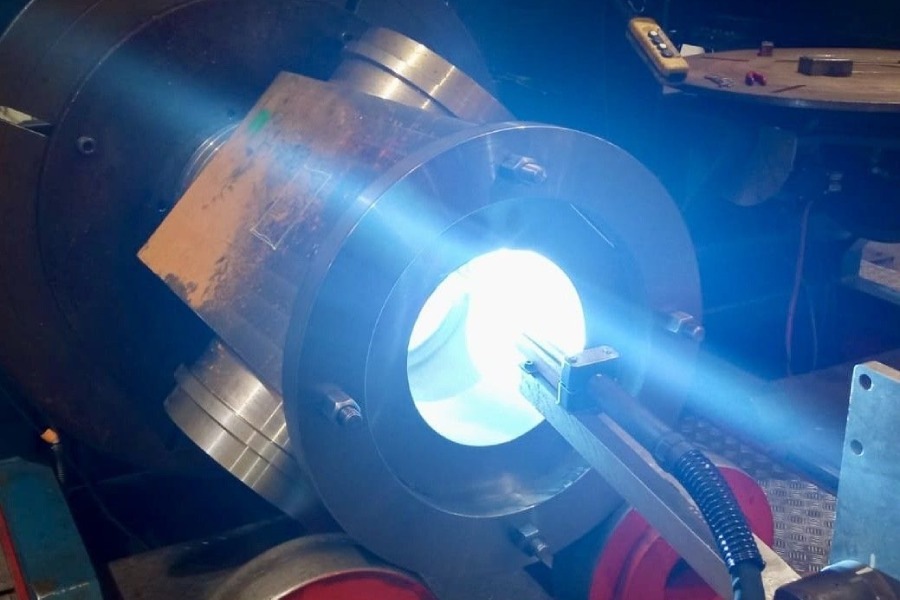
Post-failure technical support
Non-destructive testing can sometimes be used to evaluate the internal state of components after a failure to improve future strategies. In particular, liquid penetrant testing can be useful for detecting surface cracks or fissures not visible to the naked eye.
What is predictive maintenance?
Predictive maintenance relies on data analysis, algorithms, and condition monitoring to anticipate possible failures before they occur. Applied to components such as shafts, impellers, valve bodies, pump casings, covers, or regulating valves, it allows you to:
- Detect micro-wear with sensors or measuring instruments
- Apply CNC machining precision to ensure tolerances in critical areas
- Schedule periodic inspections before failure
- Extend the performance and availability of machinery
This approach is especially effective in sectors where reliability and energy efficiency in industrial valves directly impact profitability.
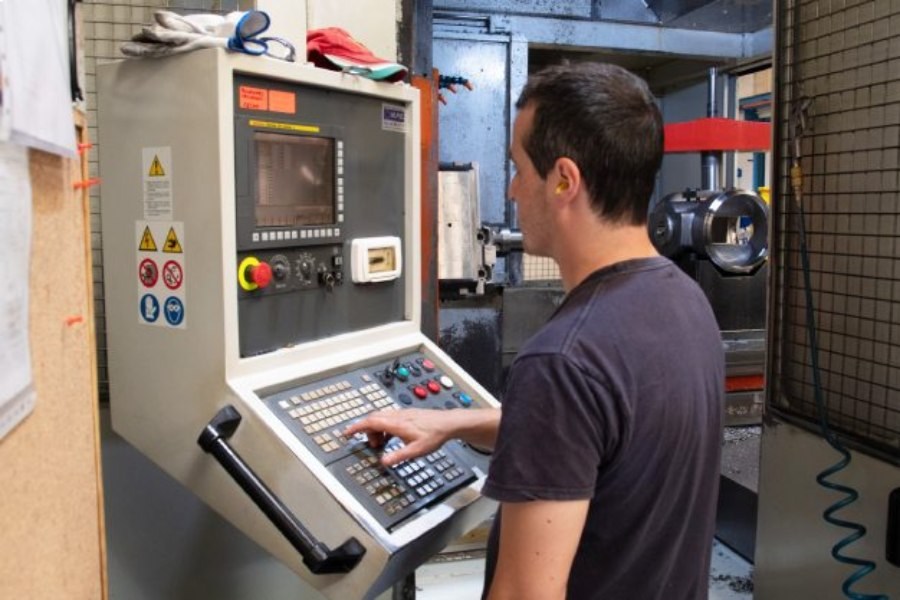
Predictive machining maintenance vs. corrective maintenance: A comparison
In this comparison of predictive versus corrective machining maintenance, it highlights how CNC machining and technical coatings improve reliability.
| Criteria | Corrective | Predictive Machining |
| Downtime | High & unplanned | Low & scheduled |
| Repair cost | High (emergencies) | Reduced (prevention) |
| Component lifespan | Shorter | Significantly extended |
| Initial investment | Low | Medium/High (sensors, SW) |
| Quality control | Reactive | Proactive & traceable |
| Process impact | High | Minimal & controlled |
This comparison reflects the added value Asimer Group provides to manufacturers who need reliability, critical tolerances, and operational continuity without margin for error.
📌 Estimated data: Predictive maintenance can reduce mechanical failures by 25–30%.
What if you don’t apply it?
Not implementing predictive maintenance on machined components in pumps or industrial valves can lead to failures with operational, economic, and safety consequences. Some concrete examples:
- Risk of failure in axial flow check valves:
Without early detection of vibrations or internal wear, these valves can fail in their one-way blocking function, causing backflows that damage upstream equipment. - Non-compliance in oil refining processes:
In Oil & Gas plants, a failure in critical valves can alter operating pressure or temperature, interrupting the process and causing financial loss or regulatory sanctions. - Loss of tightness in critical systems:
Micro-cracks not detected in time (from fatigue or corrosion) in covers, casings, or seats can cause leaks of aggressive fluids or hazardous gases, compromising system safety and efficiency. - Failures in components like diaphragm or needle control valves:
These valves are sensitive to pressure variations and dirt. Without monitoring or predictive maintenance, their degradation can cause instability in flow or pressure control. - Inspection challenges without a metrology room or measuring arm:
Without advanced dimensional control tools, it’s difficult to verify critical tolerances after machining or during service inspections, increasing the risk of functional errors. - Poor traceability without integrated systems:
If intervention data (materials, parameters, dates, personnel) is not recorded, you lose visibility on each component’s history, making it impossible to anticipate failure patterns or audit processes.
🔧 In these contexts, applying high-precision machining for cryogenic applications in pumps and industrial valves, or incorporating resilient coatings such as Stellite® or Inconel®, becomes essential to prevent premature failures and ensure operational integrity.
In such scenarios, applying high-precision machining solutions and resilient coatings—as we do at Asimer Group—is key to ensuring the durability of industrial pumps and valves.
Practical application in pumps and valves
Predictive maintenance is essential in different phases of the life cycle of critical components:
- Manufacturing centrifugal pumps:
Allows you to set tight tolerances from the design phase and anticipate behavior under real operating conditions, reducing the risk of functional errors during commissioning. - Monitoring wear in pump components:
Vibration and flow monitoring can detect imbalance or internal erosion before it affects hydraulic performance. - Identifying failures in centrifugal pumps:
Predictive algorithms and integrated sensors make it easier to diagnose cavitation, blockages, or fatigue in impellers and casings. - Machining of large-dimension valves:
Requires extreme precision to guarantee leak-tight closure. Even minimal deviations can cause pressure loss or internal leaks undetectable to the naked eye. - Use of TIG welding or automatic MIG welding:
Applied with predictive control, these avoid thermal distortion, porosity, or cracks that would compromise component tightness and durability. - Application of coatings for corrosive environments like Stellite® or Inconel®:
These coatings extend the life of valves and pumps exposed to chlorides, acids, or other aggressive fluids, minimizing wear from abrasion or corrosion. - Selecting types of coatings for industrial valves in extreme environments:
Prior application analysis lets you select tailored solutions (heat-resistant, anti-corrosive, or self-lubricating), reducing unplanned interventions.
💬 In these cases, predictive maintenance not only extends equipment lifespan but also enables tighter dimensional control, reduces assembly errors, and improves plant resource planning.
When to choose predictive vs. corrective maintenance
The choice between mechanized predictive maintenance and corrective maintenance depends on technical, operational and economic factors which determine the most effective strategy to avoid failures in industrial pumps and valves
- Cost vs. asset criticality:
If a failure may result in plant downtime, an accident or impact on critical production, mechanized predictive maintenance is the safest option. On the other hand, if the component is redundant or low-cost, corrective maintenance may be affordable. - Capacity to outsource machining and industrial welding in Oil & Gas:
En sectores como Oil & Gas, donde la precisión y trazabilidad son vitales, externalizar el mantenimiento a proveedores con experiencia en tolerancias críticas, recubrimientos especiales y soldaduras avanzadas como TIG o MIG automática permite aplicar estrategias predictivas con garantías. - Tolerances required in machining stainless steel valves and pumps:
The more exacting the tolerances (by pressure, temperature or aggressive media), the greater the need for predictive control to ensure functionality and tightness. - Production volume and complexity of fittings in Oil and Gas industry:
On lines with high rotation or multiple configuration changes, mechanized predictive maintenance helps anticipate fatigue failures or thermal cycles. On the other hand, in stable installations, the corrective action can be maintained if it is managed with periodic inspections - Ability to optimize costs in machining pumps and valves:
Collecting historical data lets you adjust maintenance intervals, reduce unnecessary interventions, and plan replacements—directly impacting energy efficiency, availability, and equipment life-cycle cost.
💬 To learn more about the machining and welding solutions for predictive maintenance that we apply to critical components, see our specialist article.
💬 If you are looking for a partner with experience in predictive maintenance services for pumps and valves, find out how we work at Asimer Group.
✅ Recommendation:
Apply predictive maintenance to high-criticality assets where failure means costly downtime, safety issues, or high technical demands. Use preventive maintenance for auxiliary or non-essential components, as long as periodic monitoring is documented and controlled.
Our experience with industrial manufacturers enables us to design maintenance strategies tailored to each asset, optimizing availability, traceability, and lifecycle efficiency.
Manufacturers who value the differences between predictive versus corrective machining maintenance find tailor-made CNC machining solutions at Asimer
CNC and technical coatings
A robust predictive maintenance strategy must rely on advanced manufacturing technologies and processes that ensure precision, traceability, and efficiency.
- Use of CNC technology with millimetric control:
Maintains critical tolerances in components such as pump bodies, valve seats, or impellers, reducing the risk of failures from misalignments or internal leaks. - Integration with Trevisan machining center for complex series:
These centers are specifically designed to machine large or complex-shaped parts precisely and repeatedly, facilitating the production of large valves or casings with multiple cavities. - Machining by chip removal processes:
Ensures clean, fitted surfaces ready for assembly or coating application, with controlled roughness to standards. Ideal for reducing friction, wear, or pressure loss. - Commitment to innovation in CNC machining applications:
Includes the use of special tools, adaptive programming, CAD/CAM simulations, and monitoring of tool wear—all reinforcing the final product’s reliability. - Implementation of technological innovations in the manufacture of industrial valves:
From coatings applied by TIG/MIG automatic welding or PTA to the use of advanced materials resistant to corrosion, abrasion, or extreme temperatures—each advancement directly impacts equipment durability.
🌱 And if environmental goals are a priority, it’s essential to work on reducing the carbon footprint in pumps and industrial valves—not just with more efficient materials, but also by optimizing machining processes, eliminating rework, and extending component lifespan.
From reactive to strategic
Predictive maintenance is more than technology; it’s an industrial culture. Moving from acting after failure to preventing with precision is key in sectors that use large valves and critical machinery. This transition not only improves operational availability but also optimizes resources, minimizes waste, and aligns maintenance with sustainability and industrial competitiveness objectives. It also encourages a culture of continuous improvement based on data, cross-department collaboration, and greater control over the industrial asset life cycle.
At Asimer Group, we help you stay ahead of industrial failures
When working with critical components such as large valves, pump bodies, or welded parts for extreme environments, there is no margin for error.
The key is not just in precision machining or advanced coatings. It’s about understanding every application, anticipating failures, and ensuring traceability and performance from day one.
At Asimer Group, we work with manufacturers of industrial pumps and valves to offer:
🧠 Customized diagnostics based on real working conditions.
🔩 CNC machining with critical tolerances and advanced measurement.
🔧 Application of Stellite®, Inconel®, TIG or automatic MIG coatings with thermal control.
📏 Dimensional reports and traceability throughout the process.
📞 Do you have a project in progress or need a quote for a technical series or unique part?
👉 Write to us and in less than 24 hours we’ll help you with a concrete proposal, no obligation.
Contact us now✅ Because prevention is not just a system—it’s a strategic decision.
Frequently asked questions about predictive machining maintenance
1. What’s the difference between preventive and predictive maintenance?
Preventive maintenance is based on scheduled inspections by time or usage, without knowing for sure if the component needs it. Predictive relies on real data (such as vibration, pressure, or temperature) to anticipate specific failures, avoiding unnecessary maintenance and reducing the risk of unexpected downtime.
2. What sensors are used in predictive maintenance for pumps and valves?
Vibration sensors (accelerometers), differential pressure, temperature, flowmeters, and thermocouples are used. This data is integrated into platforms such as SCADA or CMMS, enabling automatic alerts and real-time predictive tracking.
3. Which industrial components benefit most from predictive machining maintenance?
Those exposed to extreme conditions or continuous wear: shafts, impellers, centrifugal pump casings, valve seats, covers, welded bodies, and regulating valves. In these, a micro-crack or minimal deviation can cause severe failures if not detected in time.
4. What does Asimer Group offer versus other providers?
At Asimer Group, we combine high-precision CNC machining, technical coatings like Stellite® or Inconel®, specialized welding (TIG, automatic MIG), and dimensional control with traceability. This allows us to offer comprehensive, customized solutions to manufacturers of industrial pumps and valves who require operational reliability and critical tolerances.
5. Can I apply predictive maintenance if I manufacture unique or low-volume parts?
Yes. Even in small or one-off series, it’s possible to set alert thresholds and custom strategies. At Asimer Group, we work with manufacturers who require accuracy from the very first unit, applying measurement and predictive analysis tailored to each component.

